Angkor Wat is a temple complex in Cambodia built in the 12th century by King Suryavarman II. It is the world’s largest religious structure, covering some 400 acres (160 hectares), and marks the high point of Khmer architecture. Angkor Wat is also a symbol of Cambodian national identity and a UNESCO World Heritage Site. The architecture of Angkor Wat reflects both Hindu and Buddhist influences. The temple is designed as a microcosm of the Hindu cosmology, with a central tower representing Mount Meru, the home of the gods, and five smaller towers representing the peaks of the mountain. The temple is surrounded by a moat and three rectangular galleries, each with a gopura (gateway) at the cardinal points. The walls and pillars of the temple are decorated with bas-reliefs and sculptures depicting scenes from Hindu epics, such as the Ramayana and the Mahabharata, historical events, and everyday life of the Khmer people. The design and construction of Angkor Wat involved advanced engineering and artistic skills. The temple was built using sandstone blocks quarried from the nearby Kulen Mountains and transported by rafts along the Siem Reap River. The blocks were fitted together without mortar using a system of grooves and tenons. The bas-reliefs and sculptures were carved with remarkable precision and detail, using various techniques such as modeling, polishing, and inlaying. The temple also incorporated corbelled arches, false windows, and hidden chambers to create a sense of harmony and balance. The history and influence of Angkor Wat span several centuries and cultures. The temple was originally dedicated to the Hindu god Vishnu but was converted to a Buddhist shrine in the 14th century when Theravada Buddhism became the dominant religion in Cambodia. The temple was abandoned in the 15th century, after the fall of the Khmer Empire, and was rediscovered by Western explorers in the 19th century. Angkor Wat has attracted millions of tourists, scholars, and pilgrims from around the world and has inspired many artistic and architectural works, such as the novel The King of Cambodia by Pierre Loti, the opera The Legend of Angkor Wat by Léo Delibes, and the film Lara Croft: Tomb Raider by Simon West.
What is the Angkor Wat?
Angkor Wat is a temple complex in Cambodia built in the 12th century. It is the world’s largest religious structure, covering 402 acres (162.6 hectares), and is considered a masterpiece of Khmer architecture and a symbol of Cambodia. Angkor Wat is located near Siem Reap, 150 miles (240 kilometers) from Phnom Penh’s capital. It is part of the Angkor Archaeological Park, which covers an area of 150 square miles (400 square kilometers) and contains many other ancient temples and monuments. Angkor Wat was built by King Suryavarman II, who ruled the Khmer Empire from 1113 to 1150. He dedicated the temple to the Hindu god Vishnu and intended it to be his state temple and mausoleum; however, he died before the temple was completed, and it was later converted into a Buddhist shrine by his successor, Jayavarman VII. Angkor Wat has a rectangular plan, with a central tower surrounded by four smaller towers and enclosed by three concentric galleries. The outer gallery measures 614 by 705 feet (187 by 215 meters), and the innermost gallery measures 190 by 197 feet (58 by 60 meters). The central tower rises 213 feet (65 meters) above the ground, and the temple is decorated with intricate bas-reliefs and sculptures.
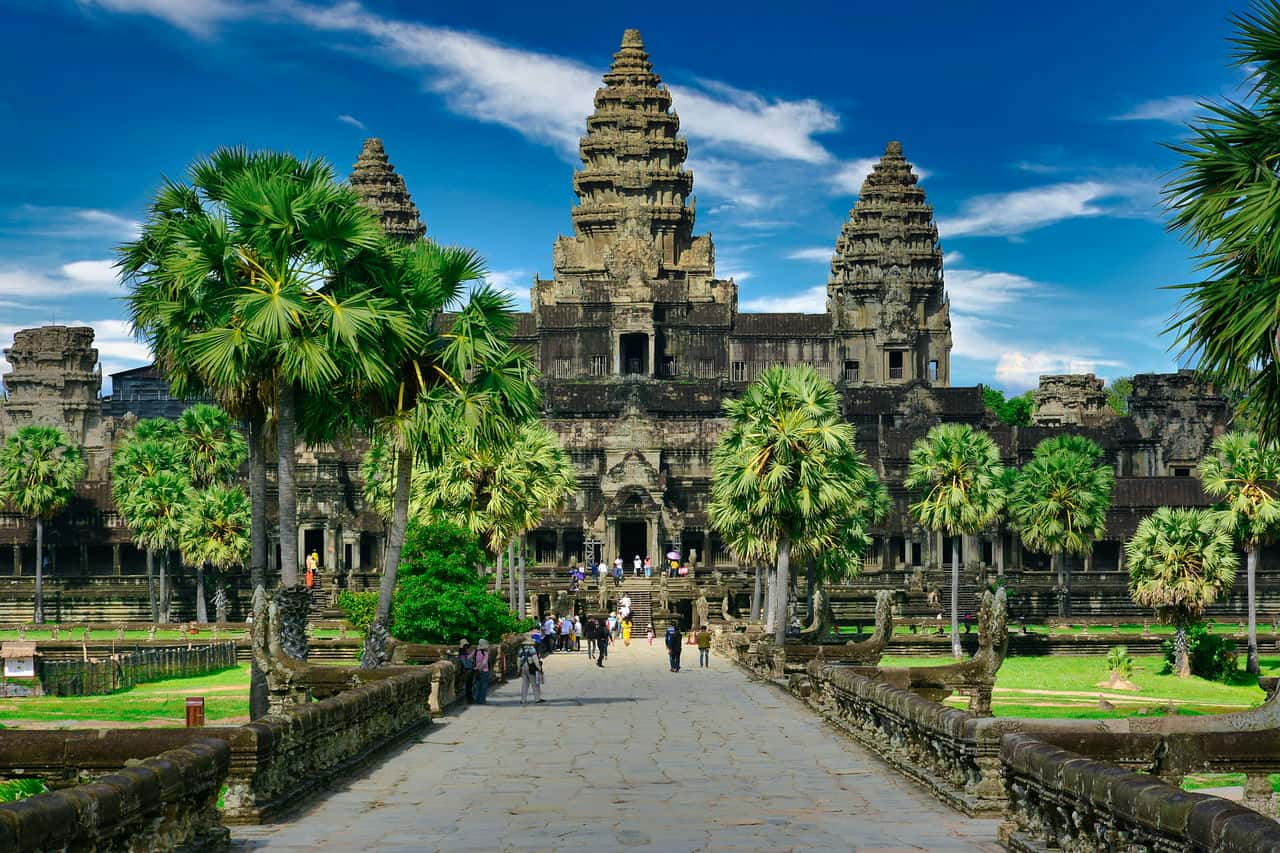
What architectural style is most prominent in Angkor Wat?
The most prominent architectural style in Angkor Wat is the Khmer style, which reflects the cultural and religious influences of the ancient Khmer empire. The Lotus characterizes the Khmer-style bud-shaped towers that taper towards the top and have curved outlines, which symbolize the sacred mountain of Mount Meru, the center of Hindu and Buddhist cosmology. Cruciform terraces extend along the main axis of the temple and provide access to the different levels and enclosures, which are decorated with sculptures of lions, nagas (serpents), and garudas (bird-like creatures), while Narrative scenes fill the walls of the temple and depict stories from Hindu epics such as the Ramayana and the Mahabharata, as well as historical events and scenes of everyday life, which are carved in bas-relief, a technique that creates a low relief by cutting away the background of the stone.
What structural engineering principles are employed in the construction of the Angkor Wat?
There are 4 major structural engineering principles that are employed in the construction of the Angkor Wat. Firstly, the temple complex features a well-designed foundation system. The builders excavated trenches and filled them with compacted earth and laterite, a type of durable rock, to create a solid base. The foundation provided stability and prevented settlement over time. Secondly, the temple’s main structure utilizes load-bearing walls and pillars. The walls are made of sandstone blocks, carefully carved, and fitted with interlocking joints. These walls distribute the structure’s weight evenly, ensuring structural integrity and resistance to external forces such as earthquakes. Thirdly, the architects incorporated various architectural elements to enhance the structural strength of Angkor Wat. The complex employs corbel arches, a construction technique where stones are arranged and stepped, gradually narrowing towards the top to form an arch. The method effectively distributes the load and reinforces the stability of the structure. Lastly, the temple complex incorporates extensive drainage systems. The builders constructed a network of canals, moats, and reservoirs to manage water flow and prevent water-related damage. These systems helped to control groundwater levels and protect the foundations from excessive moisture.
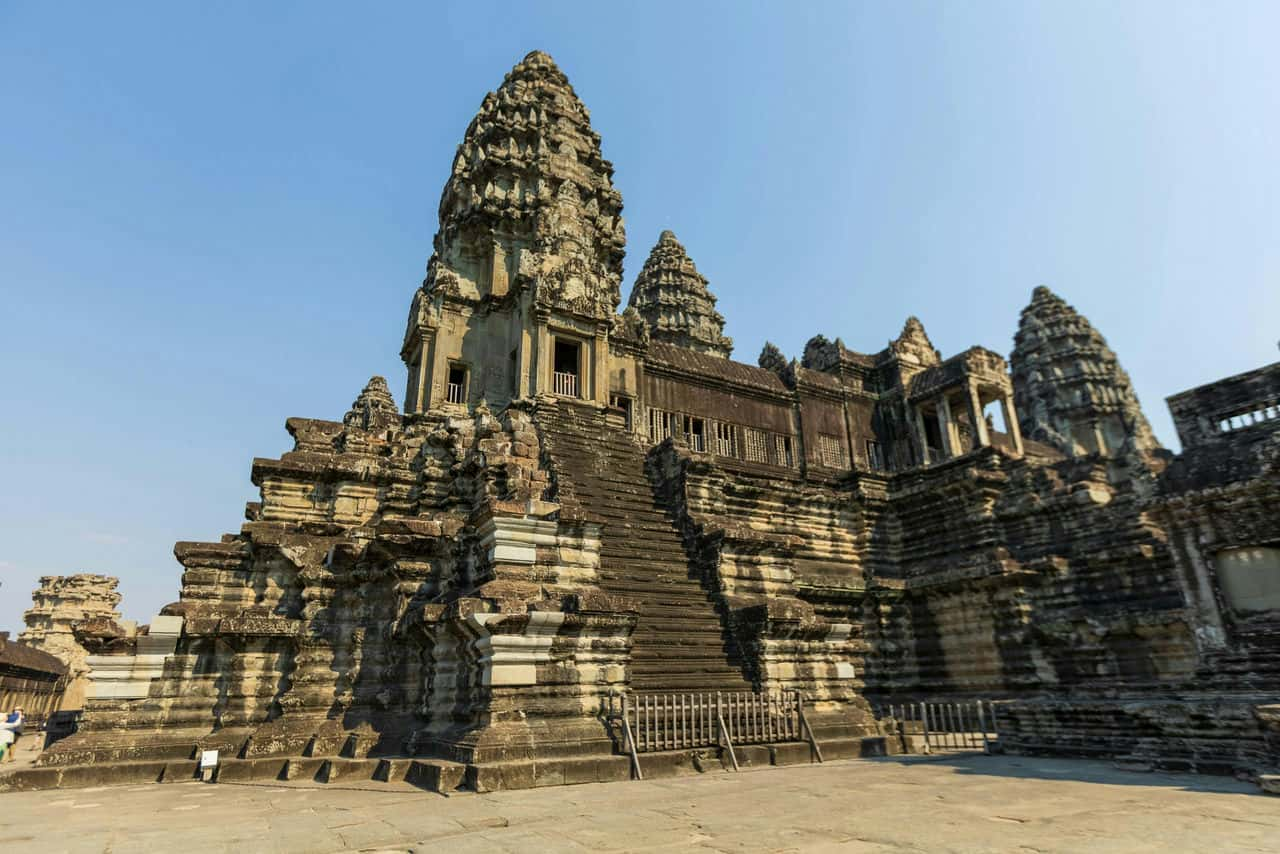
Who designed the Angkor Wat?
The architect who designed the Angkor Wat is unknown due to the lack of historical records from that time; however, it is believed that the construction of Angkor Wat was overseen by King Suryavarman II, who ruled the Khmer Empire during the 12th century. King Suryavarman II commissioned the construction of Angkor Wat as his state temple and mausoleum. He played a significant role in the planning and execution of the project, but the actual design work was likely carried out by a team of skilled architects and artisans under his direction. The architectural style of Angkor Wat reflects the artistic and cultural influences of the Khmer Empire. It combines Hindu and Buddhist traditions.
What are the historical design influences visible in Angkor Wat?
There are 4 major historical design influences visible in Angkor Wat. Firstly, Hindu influences are prominent in the design of Angkor Wat. The temple complex was originally dedicated to the Hindu god Vishnu, and its architectural elements reflect Hindu cosmology and mythology. Intricate carvings depict scenes from Hindu epics such as the Ramayana and the Mahabharata, showcasing the religious beliefs and narratives of the time. Secondly, Buddhist influences are also evident in the design of Angkor Wat. The temple complex transformed from a Hindu temple into a Buddhist site over time. The transition is reflected in incorporating Buddhist iconography and elements into the structure. Statues and reliefs of the Buddha and Buddhist deities can be found within the temple, demonstrating the integration of Buddhist beliefs and practices into the architectural design. Thirdly, the architectural style of Angkor Wat showcases the influence of Khmer architectural traditions. The temple combines earlier Khmer temple architecture elements, such as using sandstone blocks and integrating complex architectural plans. The design also incorporates unique Khmer features, including the use of corbel arches, decorative motifs, and the vast scale of the complex, reflecting the grandeur and artistic sophistication of the Khmer Empire. Lastly, Angkor Wat exhibits influences from other Southeast Asian cultures. The architectural design of the temple complex displays similarities with structures found in neighboring regions, indicating the exchange of ideas and artistic influences between different cultures. These influences contribute to the distinctive character of Angkor Wat and highlight the region’s interconnectedness of artistic and architectural traditions.
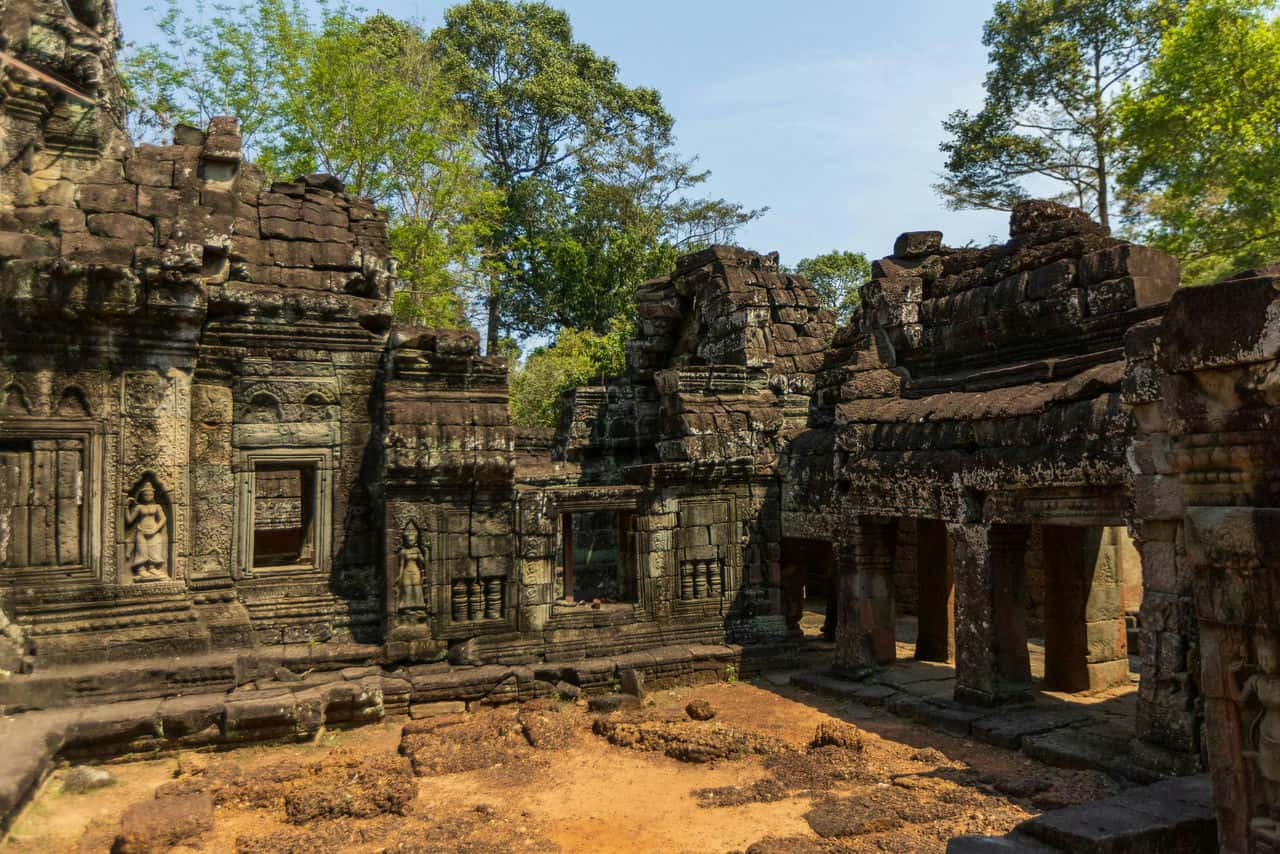
How has Angkor Wat influenced the design of other buildings in Cambodia?
The Angkor Wat influenced the design of other buildings in Cambodia in 4 ways. Firstly, the architectural style of Angkor Wat has inspired the construction of numerous temples and religious structures throughout Cambodia. The distinctive features of Angkor Wat, such as its towering spires, intricate carvings, and grand scale, have been emulated in the design of new temples across the country. These structures often incorporate elements of Khmer architecture and draw inspiration from the religious and cultural symbolism in Angkor Wat. Secondly, the layout and planning principles of Angkor Wat have influenced urban design and development in Cambodia. The temple complex is renowned for its well-organized and carefully designed layout, which includes a series of courtyards, galleries, and towers. The spatial arrangement has been replicated in planning new urban areas and public spaces, where creating distinct zones and interconnected structures enhances functionality and aesthetics. Thirdly, the artistic motifs and decorative elements found in Angkor Wat have been incorporated into the design of buildings and structures across Cambodia. The intricate carvings and bas-reliefs depicting mythological narratives and cultural scenes have served as a source of inspiration for local artisans and craftsmen. These motifs can be seen in various architectural elements, such as facades, columns, and decorative detailing, adding a touch of Khmer heritage to contemporary buildings. Lastly, the enduring legacy of Angkor Wat has contributed to a sense of national pride and cultural identity in Cambodia. The temple complex is regarded as a symbol of the country’s rich history and architectural achievements. Its influence can be seen in historical sites’ preservation and restoration efforts and the promotion of traditional Khmer architecture in modern building design.
What purpose does the Angkor Wat serve, and how does the design help?
Angkor Wat is a temple complex and functions as a place of worship and pilgrimage for followers of Hinduism and Buddhism. It was originally dedicated to the Hindu god Vishnu, which later transformed into a Buddhist temple, and now holds religious and spiritual importance for devotees. The complex provides spaces for prayer, meditation, and religious rituals, allowing individuals to engage in spiritual practices and connect with their faith. The design of Angkor Wat also helps fulfill its purpose in several ways. The complex’s grand scale and elaborate architectural features evoke a sense of awe and reverence, creating a suitable atmosphere for religious worship and contemplation. The layout of courtyards, galleries, and towers facilitates the flow of visitors and provides designated spaces for different activities, such as prayer or ceremonial processions.
How is the Angkor Wat maintained?
Angkor Wat is maintained through conservation efforts, restoration projects, and ongoing monitoring. Firstly, regular maintenance activities are carried out to preserve the physical integrity of Angkor Wat, including cleaning, repairing, and stabilizing the structures and architectural elements. Skilled craftsmen and conservators work diligently to address erosion, weathering, and structural instability issues. Regular inspections and assessments are conducted to identify areas in need of attention and to develop appropriate maintenance plans. Secondly, restoration projects are undertaken to restore damaged or deteriorated sections of Angkor Wat. These projects involve extensive research, documentation, and careful reconstruction based on historical evidence and architectural principles. Skilled artisans and experts collaborate to restore the temple complex’s original appearance and structural stability. These restoration efforts aim to balance preserving the site’s authenticity and ensuring its long-term survival. Lastly, ongoing monitoring is crucial to track Angkor Wat’s condition and promptly address emerging issues. Advanced technologies such as laser scanning, remote sensing, and geotechnical monitoring systems are employed to assess the site’s structural integrity, stability, and environmental impact. The data informs decision-making processes and helps guide future conservation and restoration efforts.
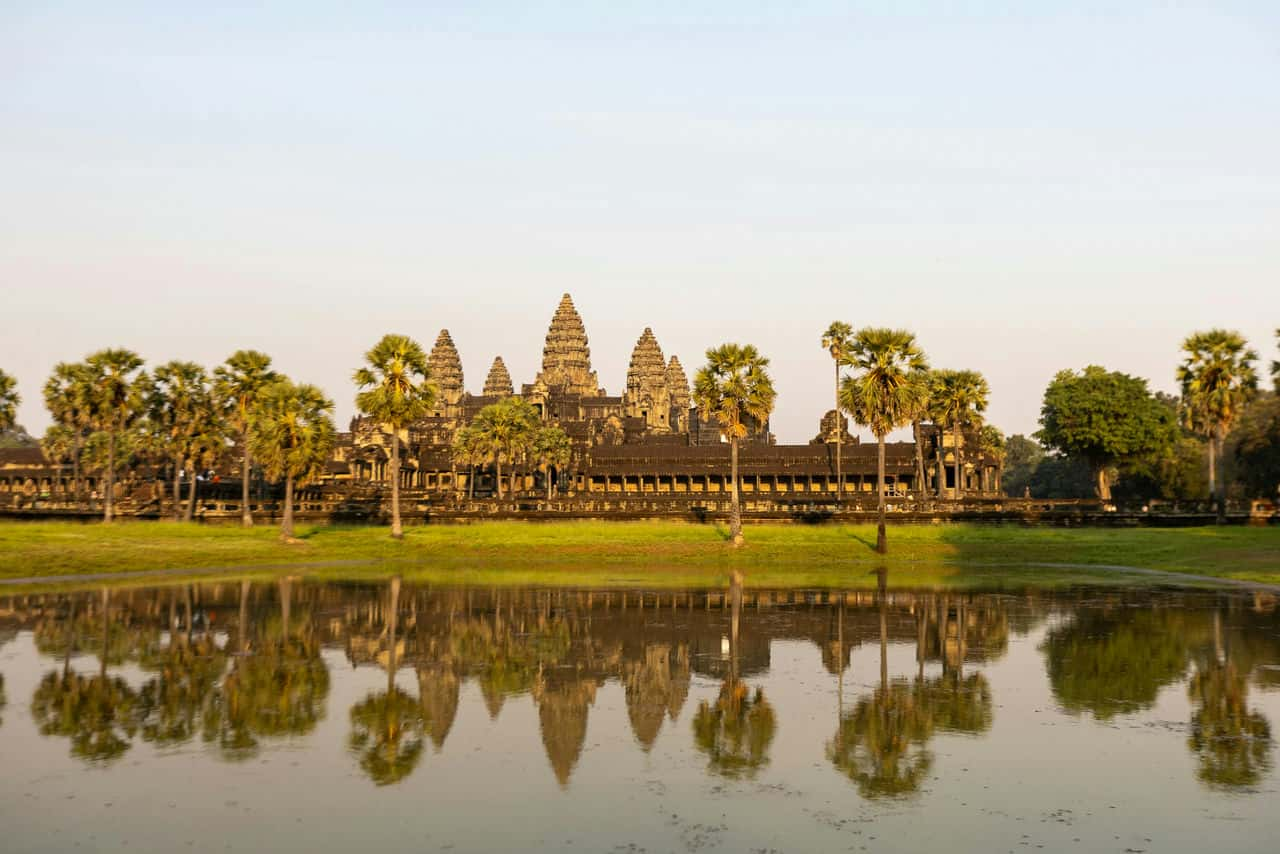
How does the Angkor Wat reflect cultural and contextual relevance in its design?
The Angkor Wat reflects cultural and contextual relevance in its design in 4 ways. Firstly, the design of Angkor Wat incorporates elements of Khmer architecture, which is deeply rooted in the cultural context of Cambodia. The temple complex showcases distinct architectural features such as towering spires, intricately carved facades, and extensive bas-reliefs. These design elements are a testament to the skilled craftsmanship and artistic sensibilities of the Khmer people, reflecting their cultural values and aesthetics. Secondly, the carvings and bas-reliefs throughout Angkor Wat depict mythological narratives, historical events, and everyday life during the Khmer Empire. These artistic representations visually record Cambodian history, culture, and religious beliefs. The intricate details and symbolism embedded in the carvings reflect the cultural significance attached to these stories and provide insights into the worldview and values of the Khmer civilization. Thirdly, Angkor Wat’s design is deeply intertwined with its religious and spiritual purpose. It was originally dedicated to the Hindu god Vishnu and later transformed into a Buddhist temple. The layout and architectural elements of Angkor Wat were carefully planned to facilitate religious rituals, ceremonies, and spiritual practices. The complex’s various courtyards, galleries, and towers are designed to create a sacred and contemplative atmosphere, inviting visitors to engage with their faith and connect with the divine. Lastly, the scale and grandeur of Angkor Wat reflect the power and influence of the Khmer Empire during its height. The sheer size of the temple complex, encompassing extensive grounds and multiple structures, is a testament to the empire’s cultural, political, and architectural achievements. Angkor Wat’s design represents the ambition and vision of the Khmer rulers, who sought to create a monumental religious site to symbolize their authority and leave a lasting legacy.
What architectural trend or movement does the Angkor Wat represent?
Angkor Wat represents the architectural trend of Khmer architecture, which was prevalent during the Khmer Empire. Khmer architecture is characterized by its distinctive features, including towering spires, intricate carvings, and extensive use of sandstone. These architectural elements are prominently displayed in Angkor Wat, showcasing Khmer architecture’s unique style and design principles. The notable aspect of Khmer architecture in Angkor Wat is a temple-mountain design, which seeks to replicate the sacred Mount Meru from Hindu mythology. The design is characterized by a central tower surrounded by several secondary towers, representing the cosmic mountain and its peaks. The temple-mountain design is a hallmark of Khmer architecture and is exemplified by the grandeur and verticality of Angkor Wat’s structure. The significant aspect of Khmer architecture in Angkor Wat is the incorporation of intricate carvings and bas-reliefs. These carvings depict various religious and mythological narratives, historical events, and scenes from everyday life. The detailed carvings reflect the Khmer’s artistic mastery and desire to communicate cultural and religious stories through visual representations. The bas-reliefs in Angkor Wat provide valuable insights into the Khmer Empire’s history, culture, and religious beliefs.
What are the challenges faced during the restoration of the Angkor Wat?
There are 4 major challenges faced during the restoration of the Angkor Wat. Firstly, one of the main challenges is preserving the original materials and structural integrity of Angkor Wat. The temple complex is constructed primarily from sandstone, prone to erosion and weathering over time. The restoration process must carefully address issues such as crumbling stone, structural instability, and the impact of environmental factors. Balancing the need to stabilize and repair the structures while maintaining the authenticity of the original materials poses a significant challenge for restoration experts. Secondly, the intricate carvings and bas-reliefs throughout Angkor Wat require delicate restoration work. These artistic features are susceptible to damage from environmental factors, pollution, and previous restoration attempts. Restorers face the challenge of preserving the intricate details and ensuring the long-term stability of the carvings while respecting the historical significance and cultural value they hold. The restoration process involves meticulous cleaning, consolidation, and, in some cases, re-carving to restore the original appearance and retain the artistic integrity of the temple complex. Thirdly, the sheer scale and complexity of Angkor Wat pose logistical challenges during restoration efforts. The temple complex covers a vast area, and addressing restoration needs across the entire site requires careful planning, coordination, and resources. Access to certain areas can be challenging, and the transportation and mobilization of equipment and materials within the complex can be logistically demanding. The involvement of multiple stakeholders, including local authorities, conservation organizations, and international experts, necessitates effective collaboration and coordination to ensure a cohesive and successful restoration process. Lastly, the impact of tourism on the restoration of Angkor Wat is another challenge to be addressed. As one of the most visited archaeological sites in the world, the influx of tourists can place additional stress on the structures and contribute to their deterioration. Managing visitor flows, implementing appropriate conservation measures, and raising awareness among visitors about responsible behavior are crucial aspects of the restoration process. Striking a balance between preserving the site’s heritage and accommodating tourism needs requires careful planning and sustainable management strategies.
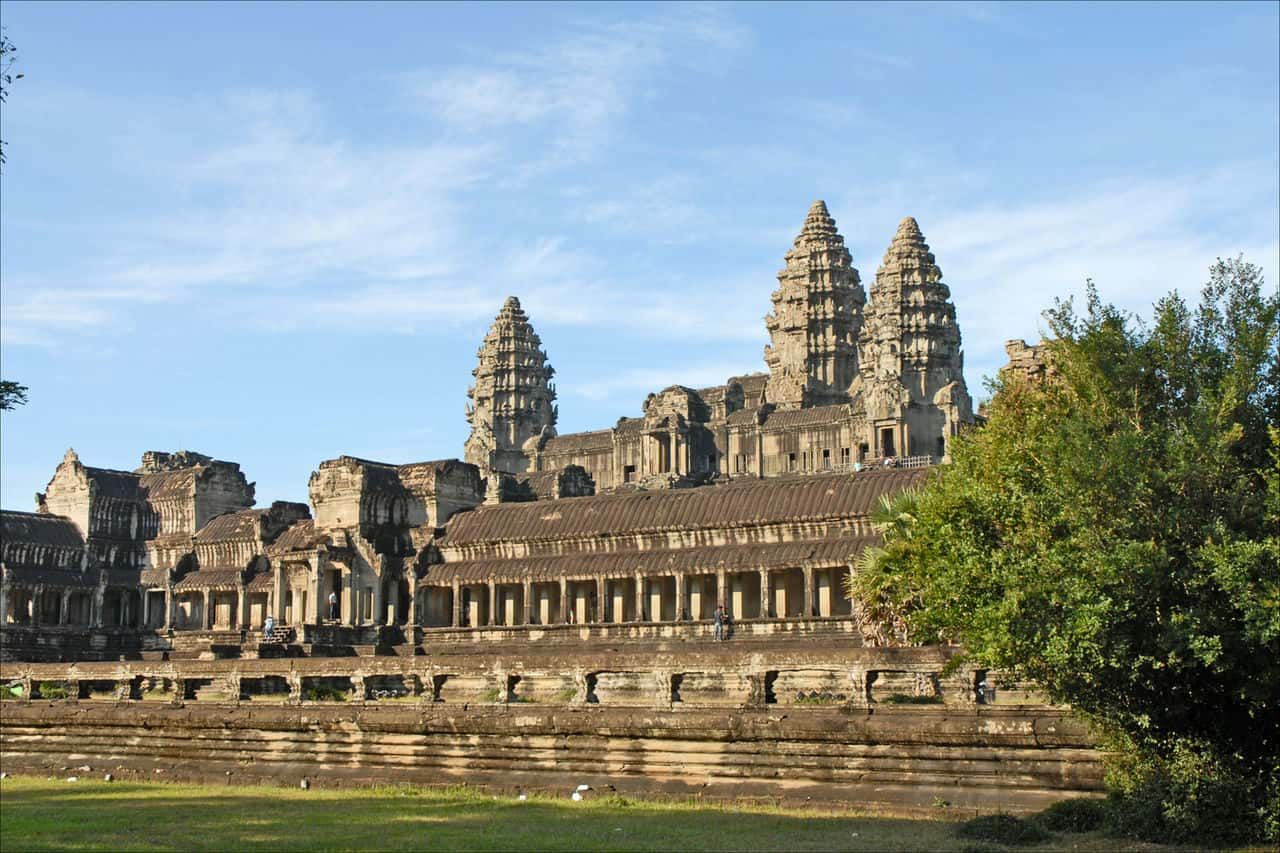
How does the Angkor Wat comply with contemporary safety and accessibility standards?
The Angkor Wat complies with contemporary safety and accessibility standards in 4 ways. Firstly, safety measures have been implemented to address potential hazards within the temple complex. Signage and barriers are strategically placed to guide visitors and prevent access to unsafe areas. Angkor Wat’s management has also improved structural stability by conducting regular inspections, reinforcing weakened sections, and implementing necessary repairs. These measures help ensure visitors’ safety and preserve the site’s integrity. Secondly, efforts have been made to enhance accessibility within Angkor Wat. Access ramps and pathways have been constructed to facilitate the movement of individuals with mobility challenges. These modifications enable visitors with disabilities or limited mobility to navigate the temple complex more comfortably. The installation of handrails and non-slip surfaces in certain areas further promotes safety and accessibility for all visitors. Thirdly, visitor facilities and amenities have been improved to meet contemporary standards. Restrooms, drinking water stations, and seating areas have been strategically placed throughout the site to enhance visitor comfort and convenience. Shaded areas and rest spots allow visitors to take breaks and seek respite from the tropical climate. These amenities contribute to a more enjoyable and accessible experience for all visitors, regardless of their physical abilities. Lastly, educational initiatives and visitor guidelines have been implemented to promote responsible behavior and awareness of safety and accessibility considerations. Informational signage and brochures guide appropriate conduct, highlighting the importance of respecting the site’s historical and cultural significance while adhering to safety guidelines. Visitor briefings and guided tours may be available to further educate visitors about the site’s accessibility features and safety protocols, fostering a greater understanding and appreciation for Angkor Wat.
Are there any specific tours for architects or architecture enthusiasts to visit Angkor Wat?
Yes, there are specific tours for architects or architecture enthusiasts to visit Angkor Wat. Angkor Wat Architecture Tour offers a detailed insight into the features and secrets of the Angkor Wat architecture style, such as the lotus bud-shaped towers, the bas-reliefs, and the narrative scenes. The tour also covers other temples in the Angkor complex, such as Bakong, Preah Khan, and Ta Prohm. The tour lasts 8 hours and costs $85 (€77.35, £73.95) per person, including transportation, guide, and entrance fees. Royal Angkor Tours company specializes in private guided tours to the Angkor Archaeological Park, with options to choose between English, Spanish, or German-speaking guides. The tours can be customized according to the interests and preferences of the visitors. They can include other attractions in Siem Reap, such as the floating villages, the silk farm, and the cultural shows. The tours range from half-day to full-day, and the prices vary depending on the itinerary and the group size. Angkor Wat Tour Guides company provides daily guided tours to Angkor Wat and other temples in the area, with experienced and licensed guides who can explain the history, culture, and architecture of the ancient Khmer civilization. The tours also include visits to the Phnom Kulen National Park, the Beng Mealea temple, and the Tonle Sap Lake. The tours last 3 days and cost $170 (€154.7, £147.9) per person, excluding transportation, accommodation, and entrance fees.
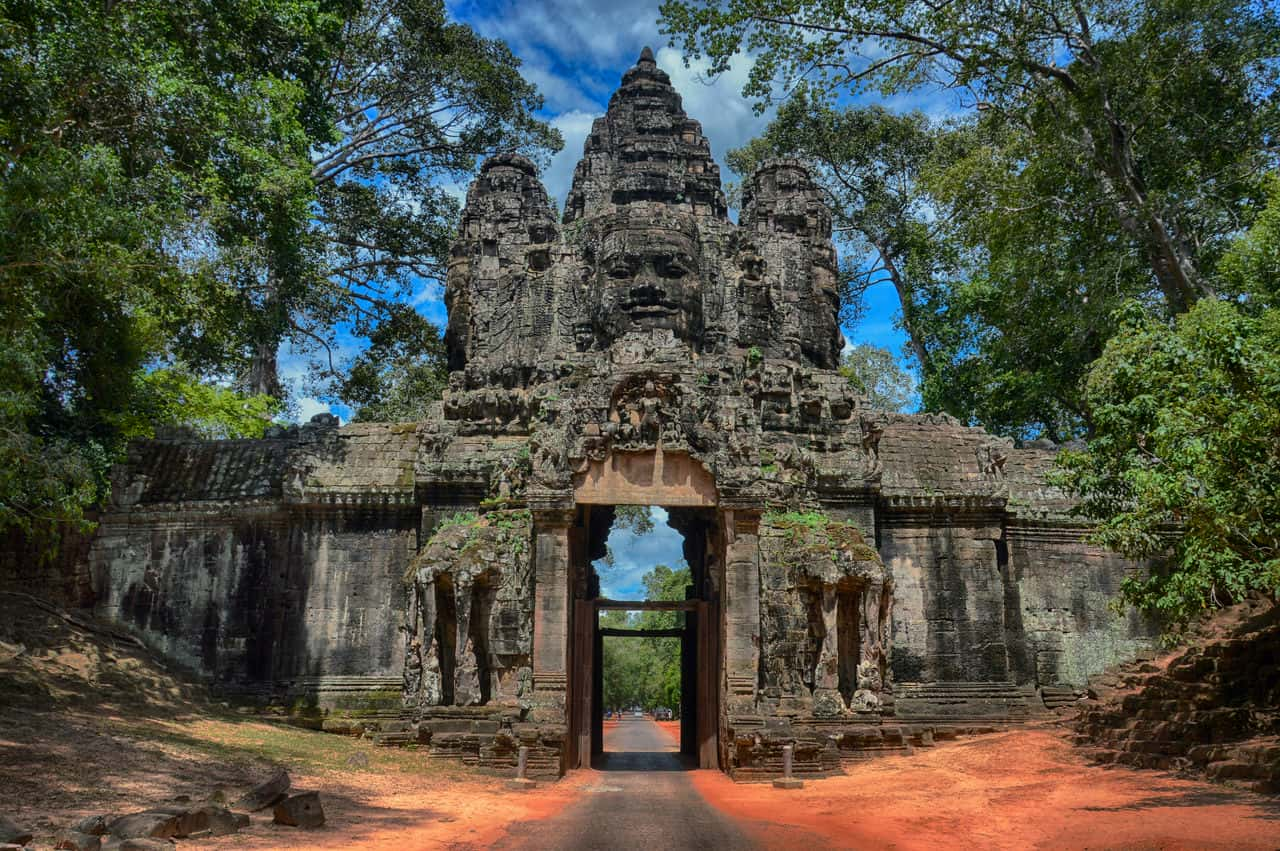
What lessons can architects learn from the design and construction of the Angkor Wat?
There are 4 lessons that architects can learn from the design and construction of the Angkor Wat. Firstly, Angkor Wat showcases the power of innovation in architectural design. Its temple-mountain design and intricate carvings demonstrate the Khmer Empire’s creative approach to constructing monumental structures. Architects can learn from the boldness and originality of Angkor Wat’s design, encouraging them to push boundaries and explore new possibilities in their architectural projects. Secondly, the structural integrity of Angkor Wat is a testament to the importance of sound engineering and construction techniques. Despite being exposed to environmental factors and centuries of wear, the temple complex has withstood the test of time. Architects can learn from the careful attention to structural stability in Angkor Wat, emphasizing the need for robust materials, solid foundations, and appropriate reinforcement to ensure the longevity of their architectural creations. Thirdly, Angkor Wat exemplifies successful cultural integration in architecture. The temple complex seamlessly incorporates elements of Hindu and Buddhist symbolism, reflecting the religious and cultural beliefs of the Khmer Empire. Architects can learn the importance of understanding and respecting the cultural context in which their projects are situated, integrating elements that resonate with the local community and contribute to a sense of place and identity. Lastly, the sustainable practices employed in the construction of Angkor Wat provide valuable lessons for architects. The use of durable and locally sourced materials, such as sandstone, demonstrates the benefits of utilizing available resources in a responsible and environmentally conscious manner. Architects can learn from this approach, considering sustainable material choices, energy-efficient design strategies, and incorporating renewable technologies to minimize the ecological impact of their projects.
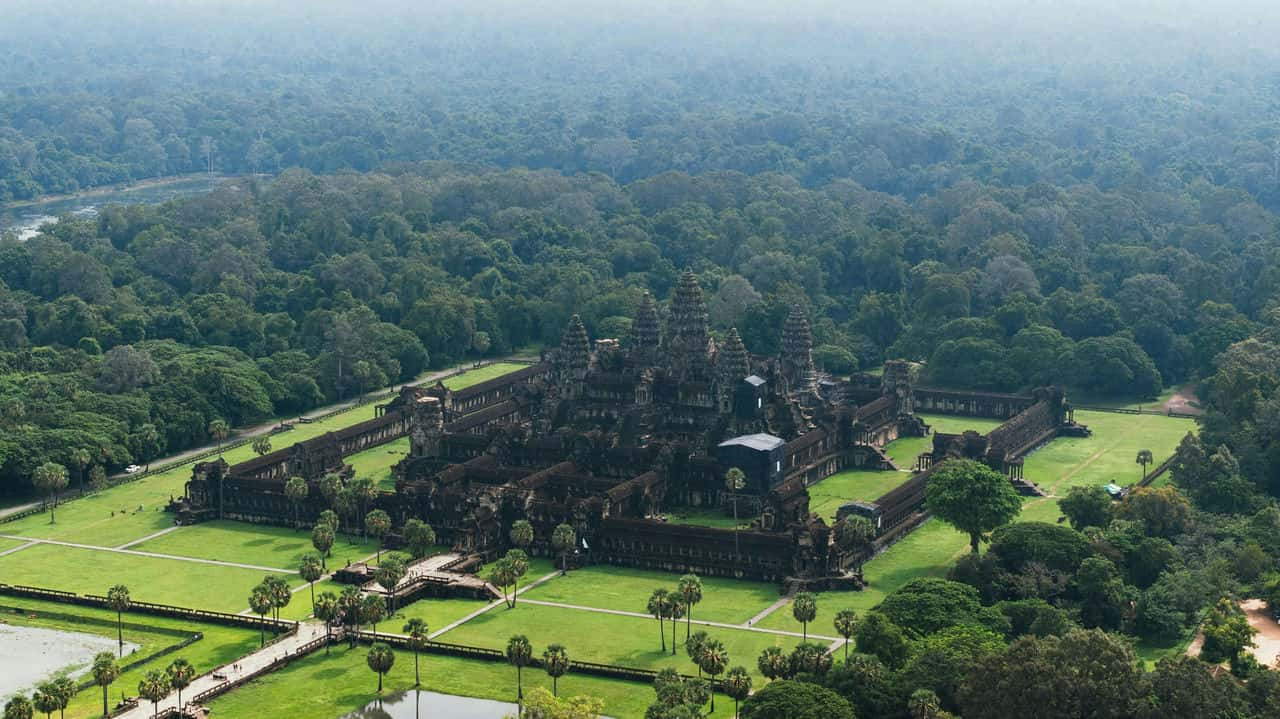
What are the best architectural landmarks to visit as an architect?
Listed below are the best architectural landmarks to visit as an architect:
- Sagrada Familia: The Sagrada Familia is an iconic basilica located in Barcelona, Spain. Designed by popular architect Antoni Gaudí, it is known for its unique and intricate architectural style that combines Gothic and Art Nouveau influences. The basilica has been under construction since 1882 and is still ongoing, making it a fascinating example of long-term architectural vision and dedication. Visitors can admire the stunning facades, soaring towers, and intricate details that make the Sagrada Familia a must-visit landmark for architects and enthusiasts alike.
- Taj Mahal: The Taj Mahal is a UNESCO World Heritage site in Agra, India. Built in the 17th century by Emperor Shah Jahan as a mausoleum for his beloved wife, it is considered one of the most beautiful examples of Mughal architecture. The Taj Mahal features intricate marble inlay work, symmetrical design elements, and a stunning white marble exterior. Its harmonious proportions and elegant details make it a masterpiece of architectural craftsmanship, attracting millions of visitors annually.
- Sydney Opera House: The Sydney Opera House is an iconic performing arts center in Sydney, Australia. Designed by Danish architect Jørn Utzon, it is known for its distinctive sail-like roof structure. The complex houses multiple performance venues and symbolizes modern expressionist architecture. Its innovative design and engineering challenges make it a significant landmark in architectural history. Visitors can take guided tours to explore the interior spaces and learn about the architectural concepts behind this world-famous structure.
- Guggenheim Museum Bilbao: The Guggenheim Museum Bilbao is a contemporary art museum in Bilbao, Spain. Designed by architect Frank Gehry, it is recognized for its striking, curvilinear form and titanium-clad exterior. The museum’s unconventional design pushes the boundaries of traditional architecture, creating a visually captivating and highly acclaimed landmark. Inside, visitors can experience a diverse collection of modern and contemporary art. The Guggenheim Museum Bilbao has revitalized the city, symbolizing urban regeneration through architecture.
- Fallingwater: Fallingwater is a residential house located in Mill Run, Pennsylvania. Designed by architect Frank Lloyd Wright, it is an iconic example of organic architecture that integrates seamlessly with its natural surroundings. The house is built over a waterfall and features cantilevered balconies and open spaces that blur the boundaries between indoors and outdoors. Fallingwater showcases Wright’s principles of harmony between architecture and nature, making it a significant landmark for architects interested in sustainable design.
- St. Peter’s Basilica: St. Peter’s Basilica is a major basilica in Vatican City, Rome. Designed by known architects, including Michelangelo and Gian Lorenzo Bernini, it is the largest church in the world and a masterpiece of Renaissance and Baroque architecture. The basilica’s grandeur is evident in its vast dome, intricate mosaics, and numerous works of art. Architects can appreciate the meticulous detailing and craftsmanship that went into creating this architectural marvel. Visitors can explore the interior, including the famous St. Peter’s Square, and marvel at its architectural and artistic splendor.
- The Louvre: The Louvre is a world-known art museum in Paris, France. Originally a medieval fortress, it was transformed into a grand palace and later became a museum. The Louvre is celebrated for its iconic glass pyramid entrance, designed by architect I.M. Pei. The museum houses an extensive collection of art and historical artifacts, including famous works such as the Mona Lisa. Architects can appreciate the museum’s architectural evolution, from its historic roots to the modern additions that have transformed it into a cultural landmark.
- Burj Khalifa: The Burj Khalifa is a skyscraper in Dubai, United Arab Emirates. Designed by the architectural firm Skidmore, Owings & Merrill, it is the tallest building in the world, standing at 2,717 feet (828 meters). The Burj Khalifa’s sleek and futuristic design features a stepped silhouette and a reflective glass facade. Its engineering marvels, such as the advanced structural systems and high-speed elevators, make it an impressive landmark for architects interested in tall building design. Visitors can enjoy panoramic views of Dubai from the observation decks on the upper floors.
- The Parthenon: The Parthenon is an ancient temple atop the Acropolis hill in Athens, Greece. Built in the 5th century BCE, it symbolizes classical Greek architecture and is one of the most influential buildings in Western history. The Parthenon showcases the Doric order with its iconic columns and pediments adorned with marble sculptures. Its harmonious proportions and refined architectural details demonstrate the principles of balance and symmetry. Architects can study the Parthenon’s design to understand the foundations of classical architecture and its enduring impact on architectural aesthetics.
- The Great Wall of China: The Great Wall of China is an ancient fortification that stretches across northern China. It is an architectural marvel and a UNESCO World Heritage site built over centuries. The wall showcases various construction techniques, including brick, stone, and rammed earth. Its strategic design incorporates watchtowers, battlements, and defensive features. The Great Wall’s vast scale and historical significance make it a remarkable landmark for architects interested in the intersection of architecture and military engineering. Visitors can explore different sections of the wall and admire the panoramic views of the surrounding landscapes.


